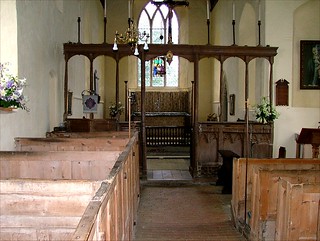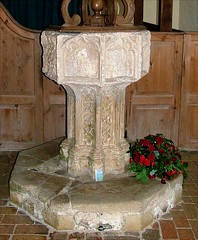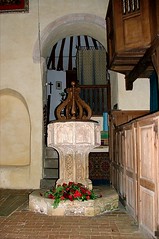| |
|
St Lawrence, Ingworth
It would be hard, I'm
sure, to come across this rugged little thatched church
and not think it beautiful. Sitting in a busy little
village just to the north of Aylsham, it has been through
the mill a bit. The tower collapsed in the early 19th
Century, and the stump was rebuilt as a vestry with its
own conical cap of thatch about a hundred years later,
giving it a kind of Arts and Crafts feel. At some point,
probably in the 14th Century, the nave was widened. There
is no arcade, no aisle, but it has left the chancel and
tower pleasingly off-centre. A new tower seems also to
have been planned, and perhaps even started, for a a
stair turret has been begun in the south-west corner. It
leads to the upper storey of the porch, and then
continues upwards for a metre or so, later being bridged
across to the now-lost old tower.
The large grass mound is at the heart of the village. The
Mill is opposite, and narrow lanes meet here, busy about
their business. An old lady was painting the wrought iron
fence on the occasion of my first visit back in 2005. She
told us that in late spring this fence keeps in the sheep
that graze the churchyard. Sheep in a churchyard is
always a pleasant sight, but it is more than that, of
course. The church, the sheep, the graves of the dead,
almost timeless. Coming back here in the summer of 2021
it was just as I had remembered it, except for one thing
I am afraid, for the church was no longer open to
visitors. A notice in the porch put up by the priest in
charge of the benefice explained that no one could be
found who was prepared to open it up and close it each
day. This was probably because of the Covid pandemic
which was still fully in people's minds at that time, but
all the other churches in the benefice were open.
And so I was not able to refresh my memory, and all the
photographs at the bottom of this page were taken in
2005. But I recalled stepping into an interior where the
19th Century restoration was masterful in leaving a neat,
rustic little church that was at once mindful of its past
and fitting for its present. Full without feeling
overcrowded, it was as if everything necessary was here,
but nothing more. Directly opposite the south doorway
there is an organ gallery on the north wall, with access
from the former tower stump. Cautley thought that the
font below it was one of the Seven Sacrament series, but
the panels have been completely erased. Turning east,
there are pastel walls and a plain, simple brick floor
stretching between makeshift benches and 18th Century box
pews. It is a church of the common people.
Beyond a cut-down pulpit with its hour-glass still in
situ, and the remains of the 15th Century screen
elaborated in the 20th Century, the tiny chancel was full
of light, with balustered communion rails and a simple
Sarum screen to the altar. It is a lovely setting for a
single panel of continental glass in the east window,
depicting the Presentation in the Temple. Balancing it at
the far end of the church is an elegant carved royal arms
for William III, an unusual survival.
This is a place to sit and just think for a moment,
especially if you are on a helter-skelter
church-exploring journey around this area as I had been
back in 2005. And then, time to go, out through the
crumbly old porch, which loving local hands have made
good and mended over the years. Two rosemary bushes
flanked the entrance, and I took a couple of cuttings. On
its little mound in the middle of its village this church
is utterly beguiling, and it seems such a shame that if
is no longer possible to go inside.
Simon Knott, February 2022
Follow these journeys as they happen at Last Of England
Twitter.
  
   
|
|
|
